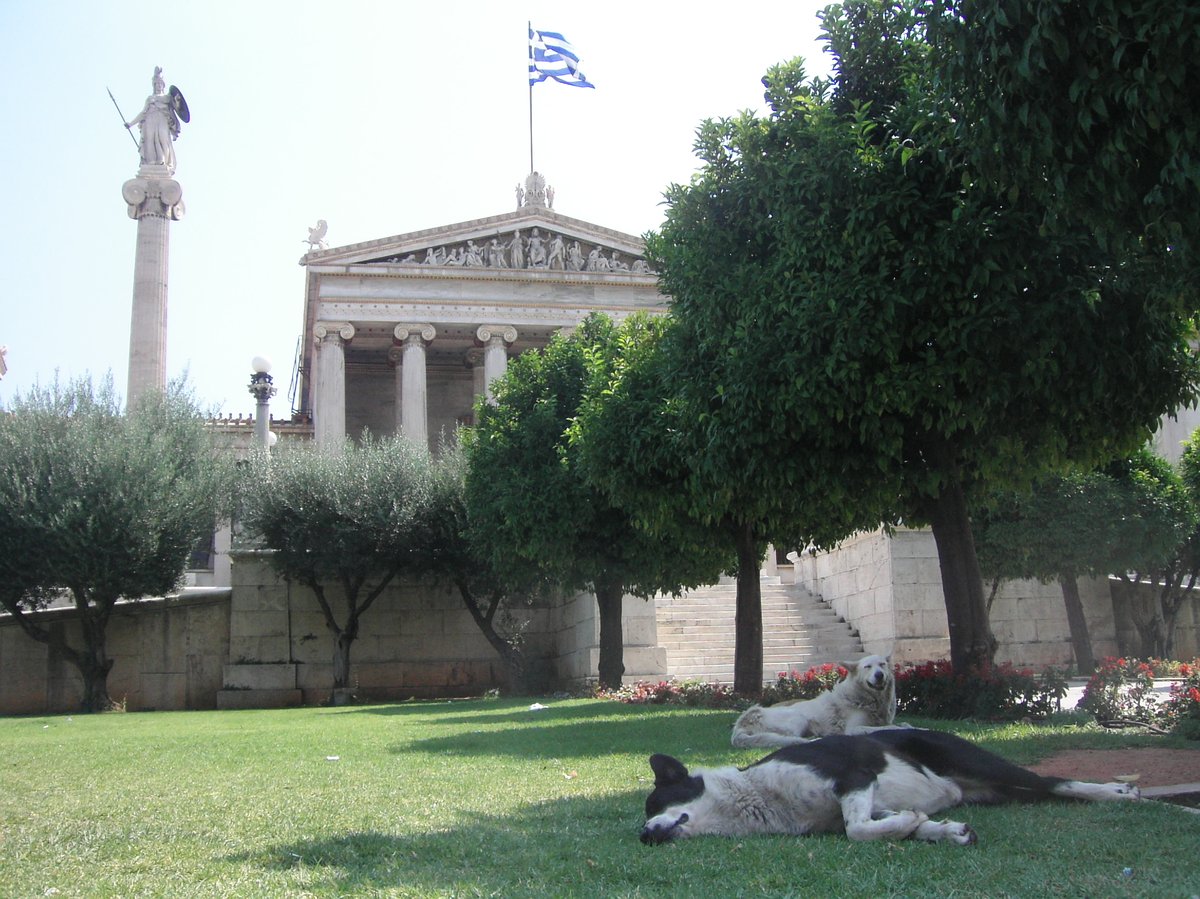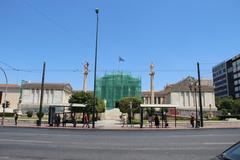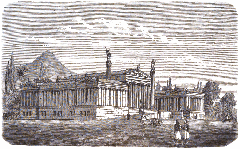
Hall of the Academy of Athens: Visiting Hours, Tickets, and Visitor Guide
Date: 14/06/2025
Introduction to the Hall of the Academy of Athens and Its Significance
Nestled in the heart of Athens, the Hall of the Academy of Athens is a monumental celebration of Greece’s enduring intellectual legacy and neoclassical architectural grandeur. Serving as both an emblematic landmark and a vital center for modern scholarship, the Hall bridges the ancient spirit of Athens—the cradle of Western philosophy and arts—with the city’s vibrant contemporary culture. From its mythological associations with Athena, the goddess of wisdom, to its central role in Greek academic life, the Hall encapsulates millennia of Greek heritage (Welcome Greece; Athens Tour Greece).
Constructed between 1859 and 1885 during Athens’ 19th-century neoclassical revival, the Hall is part of the celebrated “Neoclassical Trilogy,” which also includes the National Library and the University of Athens. Designed by Danish architect Theophil Hansen and completed under the supervision of Ernst Ziller, the building features iconic Ionic columns, elaborate sculptures by Leonidas Drosis, and murals depicting mythological and philosophical themes (Travel.gr; Athens Guide).
Visitors to the Hall are offered an immersive experience that connects ancient wisdom with modern scholarship. Whether admiring its artistic details, attending a cultural event, or appreciating its majestic façade from Panepistimiou Street, the Academy remains a beacon of Greek intellectual tradition. This comprehensive guide will equip you with everything needed to appreciate, access, and navigate the Hall of the Academy of Athens (Discover Athens; This is Athens).
Guide Contents
- Introduction & Significance
- Historical Origins and Ancient Legacy
- Neoclassical Revival and Modern Academy
- Architectural Features & Artistic Significance
- Visiting Practicalities: Hours, Tickets, Accessibility
- Travel Tips and Nearby Attractions
- The Academy’s Role in Modern Greece
- Preservation and Cultural Continuity
- FAQs
- Conclusion and Visitor Tips
- Official Sources and Further Reading
Historical Origins and Ancient Legacy
Athens is one of the world’s oldest continuously inhabited cities, with a legacy stretching back over 3,400 years (Welcome Greece). Its mythological foundation story, in which Athena triumphs as the city’s patron after gifting the olive tree, set the stage for Athens’ identity as a center of wisdom and learning. Plato’s Academy, founded in 387 BC, was the world’s first higher-learning institution, attracting luminaries like Aristotle. Though destroyed in 86 BC, its philosophical influence endures across Western thought (Athens Tour Greece).
Neoclassical Revival and the Modern Academy
The 19th-century Greek War of Independence sparked renewed interest in the country’s classical heritage. Athens’ urban landscape transformed, with the Neoclassical movement expressing both civic pride and national identity (Welcome Greece). The Hall of the Academy of Athens, constructed from 1859 to 1885, epitomizes this era. It forms part of the “Neoclassical Trilogy” alongside the National Library and University of Athens (Travel.gr).
Danish architect Theophil Hansen designed the Academy, financed largely by Baron Simon Sinas, a prominent Greek benefactor. Ernst Ziller later supervised its completion, delivering the finished Hall in 1887 (Athens Tour Greece).
Architectural Features and Artistic Significance
The Hall’s neoclassical architecture draws direct inspiration from ancient Athens, notably the Erechtheion and Parthenon. Its marble façade is dominated by a grand Ionic portico with six fluted columns. The building’s symmetry, use of Pentelic marble, and decorative friezes evoke the city’s ancient monuments (Athens Guide).
Sculptural Program
- Pediment: Above the entrance, Leonidas Drosis’ sculptural group depicts the birth of Athena from Zeus, symbolizing the emergence of wisdom.
- Statues: Monumental statues of Socrates and Plato flank the entrance, while Athena and Apollo stand atop Ionic columns, representing wisdom and the arts (Athens Guide).
- Reliefs & Motifs: Laurel wreaths, palmettes, and acanthus leaves adorn the building, reflecting classical Greek symbolism.
Interior Highlights
Inside, the Hall is richly decorated with murals and frescoes by Christian Griepenkerl, including scenes from Aeschylus’ “Prometheus Bound.” These artworks, along with the marble statue of benefactor Simon Sinas, reinforce the Hall’s intellectual mission (Shiny Greece).
Visiting the Hall of the Academy of Athens: Practical Information
Location & Accessibility
- Address: 28 Panepistimiou Street, Athens, Greece
- Metro: Panepistimio (Line 2, Red Line)
- Accessibility: Wide sidewalks and ramps around the building provide access for visitors with mobility challenges (This is Athens).
Visiting Hours
- Exterior: The façade, sculptures, and surrounding grounds are accessible to the public at all times.
- Interior: Access is highly restricted as the Hall functions primarily as a working academic institution. Public access is generally limited to special events, public lectures, or pre-arranged guided tours (Greeka).
- Typical Special Access: Tuesday to Sunday, 9:00 AM to 5:00 PM, for scheduled events or tours. Check the Academy’s official website for updates.
Tickets & Guided Tours
- Exterior Viewing: Free of charge, no tickets required.
- Interior Access: Free or subject to a fee during special events or guided tours. Bookings should be made in advance via the Academy’s website or authorized tour operators such as Discover Athens.
- Photography: Permitted outside; interior photography may be restricted during tours.
Accessibility
- Mobility: Ramps and accessible routes are available for the exterior. Interior accommodations are available during special events; contact the Academy in advance for arrangements (This is Athens).
The Academy’s Role in Modern Greece
Founded in its modern form in 1926, the Academy of Athens is the highest research establishment in Greece, continuing the legacy of Plato’s ancient Academy. It operates under three principal Orders: Natural Sciences, Letters and Arts, and Moral and Political Sciences (Wikipedia). The Academy’s research centers are internationally recognized, particularly in philosophy, science, and cultural studies. The Hall regularly hosts academic events, lectures, and exhibitions, reinforcing its central role in Greek intellectual life (Shiny Greece).
Preservation and Cultural Continuity
Athens is renowned for integrating its ancient and modern identities. Strict building regulations protect the visibility of historic monuments like the Academy’s Hall, while restoration projects safeguard its artistic and architectural value (Welcome Greece). The Hall’s location on Panepistimiou Street situates it at the epicenter of the city’s academic and cultural district (Travel.gr).
Travel Tips and Nearby Attractions
- Neoclassical Trilogy: Don’t miss the neighboring National Library and University of Athens.
- Other Landmarks: Syntagma Square, the National Archaeological Museum, the Acropolis, and the Plaka district are all within easy reach.
- Best Photo Opportunities: Early morning or late afternoon light is ideal for capturing the marble façade and statues.
Frequently Asked Questions (FAQ)
Q: What are the Hall of the Academy of Athens visiting hours?
A: The exterior is accessible at all times. Interior access is restricted to special events or guided tours, usually by prior arrangement.
Q: Is there an admission fee?
A: Exterior viewing is free. Some special events or tours with interior access may charge a fee.
Q: Are guided tours available?
A: Yes, but they are infrequent and must be booked in advance through the Academy or authorized operators.
Q: Is the Hall accessible for visitors with disabilities?
A: The exterior is accessible; for interior access during events, contact the Academy ahead of time.
Q: How do I get there?
A: The Hall is centrally located on Panepistimiou Street, near Panepistimio metro station (Line 2).
Conclusion and Final Tips
The Hall of the Academy of Athens is a must-see for lovers of neoclassical architecture and Greek intellectual history. While interior access is limited, the building’s stunning exterior, symbolic statuary, and its role in Athens’ cultural life make it an essential stop. Check the Academy’s official website for updates on public events and tours, and consider using the Audiala app for audio guides and exclusive content. Combine your visit with a tour of the surrounding Neoclassical Trilogy and historic Athens landmarks for a full intellectual and cultural experience.
Official Websites and Further Reading
- Welcome Greece: History, Architecture, Tickets & Tips
- Athens Tour Greece: Visiting the Hall of the Academy of Athens
- Travel.gr: Best Monuments and Landmarks in Athens
- Athens Guide: Visiting Hours, Tickets, and Architectural Highlights
- This is Athens: Academy of Athens Information
- Greek Reporter: Academy of Athens Neoclassical Masterpiece
- Greeka: Academy of Athens Visiting Information
- Greece-is.com: The Athenian Trilogy
- This is Athens: Accessible Routes
- Discover Athens Tours
- Shiny Greece: Academy of Athens
- Academy of Athens Official Website























































































